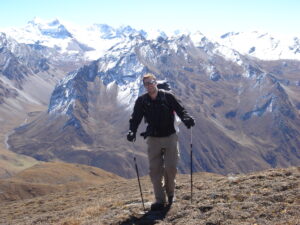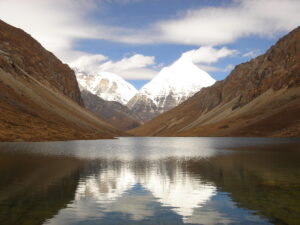Description
Group Size: Maximum 8 persons, minimum 2 person
Tour Grading: Moderate
Activity: Trek and Cultural
Sights: Tiger’s Nest monastery, Punakha Dzong, Paro Dzong, Thimphu Centenary Market, Kuenselphordang, Painting School of Arts and Crafts, Textile Museum, National Museum, Madman Temple.
Best Season: March, April, May, September, October, and November
Trip Route: Paro, Thimphu, Punakha, Shana (trek starts), Soi Thangthangka, Jangothang, Bontela to Dumzo, Thongbu Shong, Shana (trek ends) & Paro
Starting at Shana-Paro, this trek passes through scattered hamlets and farmland into a deep and richly forested valley, which leads to high alpine pastureland where yak herders graze their animals. This trek takes you to the base of this mountain to embrace the charm & experience the tranquility of the area, and it offers a taste of the great variety of Bhutanese landscape.
Trip Highlights
- The only capital in the world without a traffic light
- Bhutan Postal Museum, Evolution of Communication Systems in Bhutan
- Dochula Pass
- Chimi Lhakhang, the temple of fertility
- Tiger’s Nest: an exhilarating task of 2 hours of climbing and another 1.5 hours of retrieving steps
- Yak grazing on highland pastures
- Day 1: Arrive at Paro, drive to Thimphu
Arrive in Paro, drive to Thimphu: 55km, 1.5hours
On arrival, drive for 20 minutes to Paro town (2300m). From here, walk to Paro Dzong, crossing the cantilever bridge. This 17th-century fortress will introduce us to the Bhutanese way of life.
Drive to Thimphu (2400 m), the nation’s capital. In Thimphu, check-in at the hotel and take a rest. Later, visit the Memorial Chorten (stupa), a monument built in memory of the Third King of Bhutan by the late Royal Grandmother Ashi Phuntsho Choden Wangchuk in 1974. It is also dedicated to world peace and prosperity. People from all walks of life circumambulate the chorten, but mostly we see those elderly people throughout the day hauling away at a room-sized giant prayer wheel right next to the entrance.
In the evening, visit Tashichho Dzong, which, in its present incarnation, was consecrated as late as 1969, and this building is a visual delight. Unlike other Dzongs, this ‘peacetime’ one has three entrances: one for the common folk, leading to the administrative establishment; another to the monastic section in whose courtyard Tsechu has performed annually; and the third only for royalty.
Overnight in the hotel.
Day 2: Thimphu Sightseeing
Folk Heritage Museum: The restored three-story timber building replicates a traditional farmhouse and gives a pure glimpse into rural Bhutanese life and its households. To maintain our knowledge of indigenous natural resources, native trees and plants that had domestic uses in rural Bhutanese households are grown, creating an oasis of greenery right in the heart of the capital city of Thimphu.
National Textile Museum: Under the royal patronage of the youngest Queen Mother, Ashi Sangay Choden Wangchuck, the museum preserves the national textile and helps women’s empowerment. They help women from the central and eastern parts of Bhutan through weaving. The museum also focuses on royal ghos, including the wedding clothes owned by the fourth king and his four wives.
Centenary Farmers’ Market: Every Saturday and Sunday, most of the Thimphu population congregates on the banks of the river, where the weekend market is held. Here, villages from the valley and other nearby villages come to sell their agricultural products.
Afternoon visits to the Post Office Museum and making customized stamps. The museum was established in November 2015 to commemorate the 60th birthday of the fourth king. The museum tells the story of Bhutan’s development and progress over time. Methods such as anecdotes, artifacts, and the rich assortment of stamps the country has developed are used.
Jungzhi Paper Factory: The tree barks of Daphne and Dhekap are used to make this traditional paper. You could indulge in the whole process and try making souvenirs of your own. The paper was originally used by monasteries for manuscripts and prayer books.
In the evening, drive to Kuensel Phodrang, Buddha Point. This 169-foot bronze statue of Buddha Dordenma, Vajra Throne Buddha, symbolizes indestructibility. The view of Thimphu Valley from this point is spectacular and beautiful, especially at night.
Overnight in the hotel.
Day 3 and 4: Thimphu to Punakha, 75 km, 3 hours
Today, after breakfast, we will drive back to Punakha Valley (1220m). Punakha served as the capital of Bhutan until 1955, and today it is the winter residence of the Central Monk Body.
On the way, we will stop at Dochula Pass (3150m) to see 108 Chortens, and if we are lucky, we will see the spine of the Himalayas. Keep an eye on Gangkar Puensum, which is the world’s highest unclimbed mountain.
With a lunch stopover at Messina, we will then visit the Madman’s Temple (Chimi Lhakhang), built in 1499 and located on the hillock in the center of the valley. It is dedicated to Lama Drukpa Kunley (1455–1529), who used humor, songs, and outrageous behavior to dramatize his teachings and hence was also known as "Divine Madman.”. It is widely believed that childless couples who pray at this temple are usually blessed with children.
In Punakha, we will drive along the Pho Chu River and then cross the suspension bridge. After a short, pleasant walk, we will enter the historic 17th-century Fortress Punakha Dzong’. It was built in 1637 by Zhabdrung Ngawang Namgyal and is connected to Bhutan’s historical traditions.
Overnight in the hotel.
Day 5: Punakha to Paro
Morning drive to Paro followed by an orientation tour of Paro Valley’s main sights, including the Rinpung Dzong with its cantilever bridge, Kyichu Lhakhang, a most revered temple boasting an orange tree that perpetually bears fruit, and the ruins of the Drugyel Dzong – the site of the fort of Drukpa victory from which the Bhutanese effectively repelled constant attacks from Tibet, and from where, on clear days, the 24,000-foot snow-domed peak of awesome Mt. Jumolhari can be seen.
Overnight in the hotel.
Day 6: Shana (trek starts) to Soi Thangthagka
Soi Thangthangka (3,610m), approximately 22km. 8-hour trek, 770m ascent, 10m descent
From Paro, we drive north to Drugyal Dzong, then continue to drive along the new farm road to Shana Zam (2850m), which takes about 2 hours. After loading the pack animals (ponies) with your luggage and trekking gear or supplies, we begin a 3–4-hour trek through J.DW. National Park.
Accompanying the group are the horseman, ponies, a guide, a cook, and assistants. Approx. 8km. 3–4 hour trek, ascending about 300 m (1m = approximately 3.28ft). Continue up through the valley, following the Paro River, which gradually narrows as the trail leads higher, winding up and down through a thick, lush forest of oak, pine, cider, and juniper as we get closer to our camp for the night.
Overnight in Tents Camp at around an altitude of 3600m.
Overnight in the tent.
Day 7: Trek to Jangothang (base camp)
Approximately 19km, 5–6 trek. 480m ascent
Continue following the Paro River as the valley begins to widen, opening to a spectacular area surrounded by high ridges and snow-capped peaks. A few yak-herding villages are based in this area. Today is not a long day but because of altitude gain, the pace is slower. Camp at Jangothang (4,080 m) is below a ruined fortress, with Mt. Jomolhari seemingly nearby. There is a nice little trekker hut that can be used for dining and as a fireplace.
Overnight in the tent.
Day 8: Jangothang (rest day or explore)
Jangothang is one of the most spectacular camping places in the entire Himalayas. You may wish to enjoy the view and rest for the challenge ahead, take excursions towards the glaciers of Juomolhari, or visit a local village nearby.
Overnight in the tent.
Day 9: Dumzo Trek across Bontela to Dumzo
Approximately 16km, 7 hours. 810m ascent and 1090m descent
The trek is now more serious. The trail starts with a steep hike to Tshopu Lakes and gradually climbs up to Bhonte La Pass (4,890m). Around these areas, we can often see blue sheep, fat marmots, and migrating Himalayan birds, as well as incredible views of Jichu Drake, a beautiful snowcapped peak alongside Jomolhari. After the pass, it is a steep descent downhill to the small yak-herding village of Soi Yaksa, or Dumzo, at 3800m.
Overnight in the tent.
Day 10: Thongbu Shong
Approx. 11 km, 5 hours of trek. 720m ascent, 340m descent.
Our hike starts with a gentle uphill trail to the top of the eastern ridge of the Soi Yaksa Valley. From here, enjoy an incredible view of the amphitheater of mountains to the north. Cross Takhungla (4,520m) and descend to our campsite in a wide grassy Thang by valley at 4,150m.
Overnight in the tent.
Day 11: Trek to Shana (trek ends)
Approx. 13km 5hr 200m ascent and 1650m descent
This morning, after the last breakfast at the camp, bid farewell to the trekking crew.
After a short, steep climb out of camp, leave the remote mountain area by following a ridge to Thombu La (4,380m). From this vantage point, we get a glimpse of the Paro Valley to the south and mountain views all around. Start the steep descent and rejoin our route to Shana (where we first began your trek). Here, meet the driver and drive to Paro.
Overnight in the hotel.
Day 12: Paro Sightseeing
This is a contingency day in case of any delays on the trek due to weather or other conditions. If everything works out as per schedule, we have a full day to tour Paro Valley, where we take short walks and visit Rinphung Dzong, 7th-century Kichu Lhakhang temple, walk to Dzongdrakha cave temples, and stroll around.
Overnight in the hotel.
Day 13: Paro (hike to Tiger’s Nest monastery)
Full day for a hike to the famous Takshang (The Tiger’s Nest) monastery, a quintessential Bhutan travel experience. As you will have covered more grounds on foot, we hope to take you beyond Takstang to visit more remote monasteries further uphill. Return to Paro for a farewell dinner.
Overnight in the hotel.
Day 14: Departure
After an early morning breakfast, depending on the flight schedule, drive to Paro International Airport for departure to the onward destination and bid farewell.










